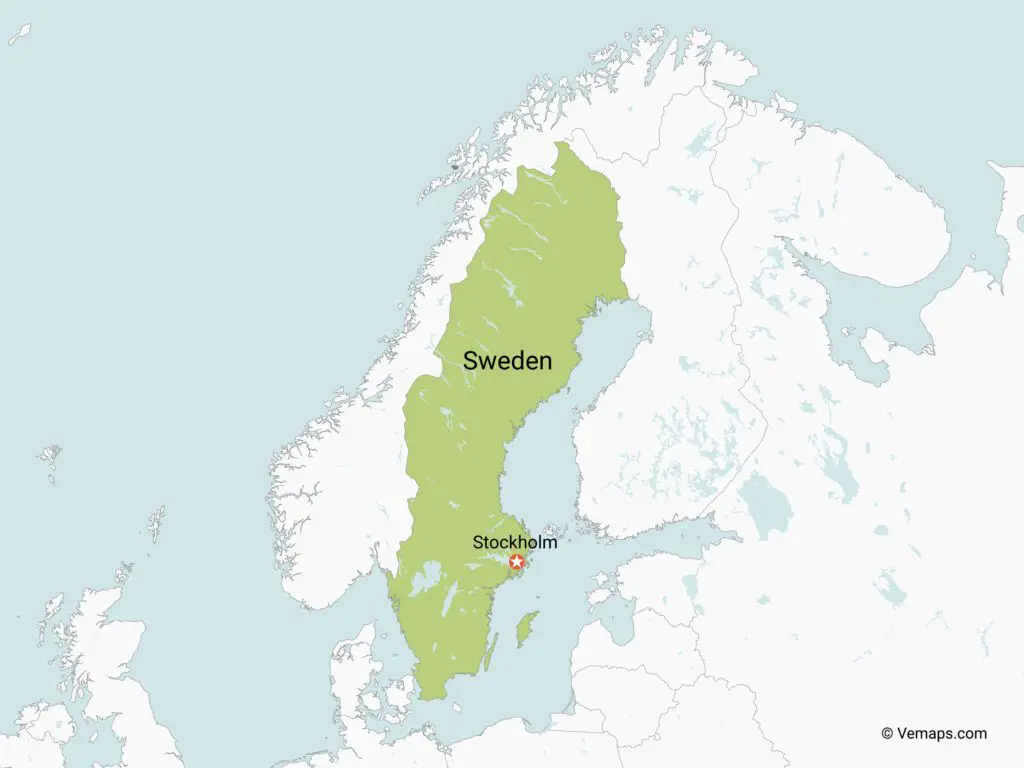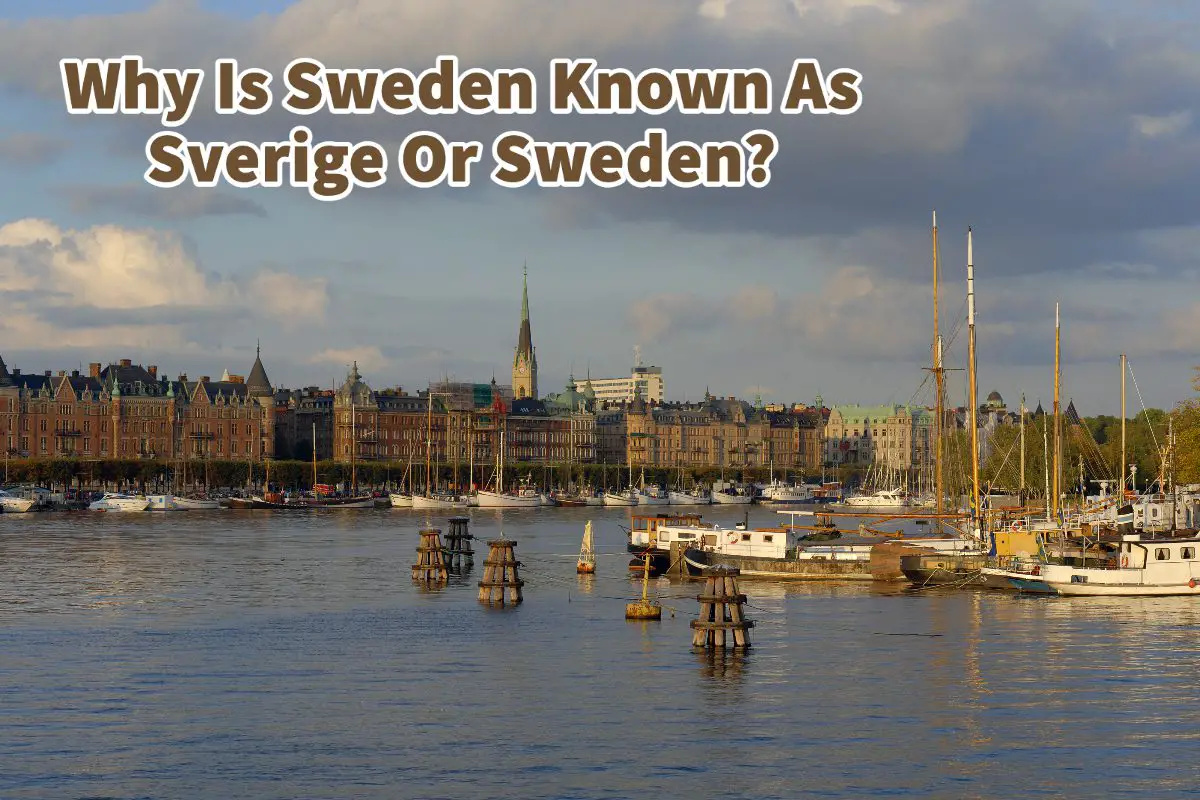My mother was born and raised in Stockholm, Sweden, and I spent some time there during my high school years. I asked my mother if she knew where the name Sweden came from, and she said she was not sure. So they started my quest to discover why Sweden is named Sverige or Sweden.
Sweden is known as Sverige in Swedish, as most people believe it came from the name of the ancient northern Germanic tribe that has occupied the area of Sweden for over 1,000 years. This ancient tribe was known as Sver or Svear. Depending on your translation, Sverige can mean Kingdom of the Sver people or “Our Kingdom,” which refers to when the Gotar and Svear people joined together as one group.
Table of Contents
- History Of The Word Sverige
- The Svear & Gotar People and Sweden
- Svear & Gotar and Expansion Of Sweden
- Related Questions
History Of The Word Sverige
Sverige is the name for Sweden in the Swedish language. The name is from the older name in old Swedish, “Swerike.”
The name “Swerike” can be broken down into two parts as follows:
- Swer or Sver – Most people believe this comes from a group of people who were known as the Swear. They were a northern Germanic tribe that had occupied the land of Sweden for thousands of years.
- Rike or Rige – The word Rike meant realm or kingdom. You can still see its use today in words like the ”Riksdag” which is the name for the present-day Swedish parliament.
It is believed that the name Sverige came from these two names, meaning the Kingdom of the “Swer” or “Sver” people.
Some linguists feel that the word does not come from the Sver or Swer people but actually from the word meaning” Sve/Svea,” which means” our/us,” so that instead, Sverige means” Our Kingdom.”
The Svear & Gotar People and Sweden
The Svear is a prehistoric clan living around Lake Malar in Sweden. Another historic clan also lived in the area, known as the Gotar, who some feel are the original Goths.
The Gotar’s lived in Ostergotlad, Vastergotland, and Smaland in present-day Sweden. The groups spoke different dialects of the Sweden language.
Even today, there are some dialect differences in the Swedish language for these areas of Sweden.
Present-day Skane, or the very southern part of Sweden, was not in the group as this area of Sweden was taken from the Danish crown in the 17th Century. What is also not part of the two tribes’ territory was Norrland or the northern part of Sweden; Norrland was also later colonized by the Swedes.
So when you look at the traditional group of people who inhabited Sweden, it is centered around these two groups of people, the Svear and Gotar.
If the name of Sweden is based upon the word” Sve/Svea,” which means us or our, it also makes sense that as the Gotar and Swer people decided to join together, they called their new kingdom. “Our Kingdom.” Using “our kingdom” was a simple way to signify these two groups joining together as one group of people or one society.
These tribes may have seen the need to join together to ensure their survival and so that they could be much stronger as one group instead of two separate groups. It seems that culturally and linguistically, they were both very similar groups.
Svear & Gotar and Expansion Of Sweden
The Gotar and Swear are the original groups of people who inhabited parts of Sweden. Over the years, they expanded northward and southward to be what Sweden is today.
Here are a few facts about these groups of people of Swer and Gotar who once inhabited Sweden and how Sweden started to expand: :
- Rome Mentioned Sweden – As early as 98 CE, the Roman Author Tacitus mentioned the Svear or what was also known as Suiones people in this part of Northern Europe.
- Northern Germanic Tribe – The Svear and Gotar groups were Northern Germanic Tribes.
- Powerful Tribe In Northern Europe – The Sverige people were a powerful northern German Tribe. Their King claimed to be a descendant of Freyr, a god from Norse mythology.
- Several Names For The Area – Like most of the world during this time, Sweden underwent name changes from the ancient name Svithiod to Swerike to Sverige. Sweden’s names include Swerike, Svearike, Swerighe, Swerghe, Swirghe, and Svealand. Some of these are alternative spellings of the same name of Sweden or Sverige.

- Stockholm Is An Old Capital – Stockholm has been the capital of Sweden since 1523, making it an ancient capital.
- Over 1,000 Year History – Sweden has over 1,000 years of continuous history as a sovereign state, even though its territory has changed over this time. But it still means that Sweden as a country has a long history.
- Traditionally Very Homogeneous Society – Sweden was always a very homogeneous society. In recent years this has changed with their liberal immigration policies. Divided into several regions with historical significance, Sweden has been traditionally divided into 3 regions: north, central, and southern Sweden.
Despite these three groups of people, Sweden has not had any significant wars or disagreements within Sweden. That truly is a fantastic feat for everyone to live together on the same land for so long without any crucial issues. As a country and a sovereign state, Sweden is an ancient culture and people.
When we think of Asian cultures, we often think of places in China, not Europe. But the truth is that for over 1000 years or more, the same group of people have habitat the land of Sweden.
And in that time, the Swedes pretty much lived a peaceful and quiet life without any significant wars or dissensions within the country of Sweden wars except for the 1521 Swedish War of Liberation.
At A Bus On A Dusty Road, we talk about everything about travel, life, sailing, and ex-pat living. We are all about “Living Life As A Global Citizen.” We explore social, cultural, and economic issues and travel.
We would love to have you be part of our community. Sign up for our newsletter to keep up-to-date by clicking here. If you have any questions, you can contact me, Anita, by clicking here.
Listen to our Podcast called Dusty Roads. You can find it on all major podcast platforms. Try out listening to one of our podcasts by clicking here.
Subscribe to our A Bus On A Dusty Road YouTube Channel filled with great videos and information by clicking here.
Related Questions
Is It Always Dark In Sweden? About The Midnight Sun
It is not always dark in Sweden; it is only dark in winter. Southern Sweden and Northern Sweden can have a very different amount of darkness in the winter. Some parts of northern Sweden do not see any light for many months during winter. Southern Sweden will have more sunlight than north Sweden in the winter month.
By clicking here, you can discover why Is It Always Dark In Sweden? About The Midnight Sun.
Lapland Or Sapmi – In Norway, Sweden, Finland, And Russia
The Sami are indigenous people who live in northern parts of Norway, Sweden, Finland, and Russia, known as Lapland or Sapmi. Most Sami people live in Norway and Sweden, some in Northern Finland and a few in Russia.
By clicking here, you can discover Lapland Or Sapmi – In Norway, Sweden, Finland, And Russia.
Norway, Denmark, And Sweden Celebrate Christmas On December 24th.
Norway, Denmark, and Sweden celebrate Christmas on December 24th because Christmas day was permanently reserved as a holy day. The Scandinavians also celebrate on the eve of a sacred day, not on the holy day itself. Many Scandinavians would attend a church service mass on Christmas morning.
By clicking here, you can discover more by reading our blog Norway, Denmark, And Sweden Celebrate Christmas On December 24th.


